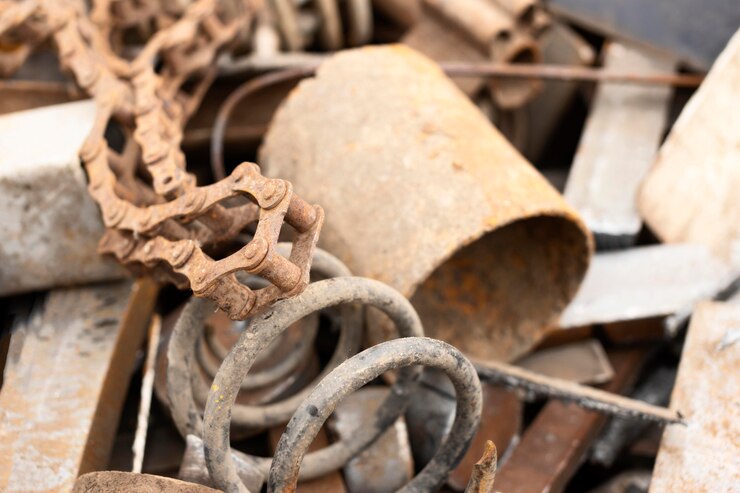When diving into the world of scrap metal collection bolton, it’s crucial to understand the different types of metals and their market values. Knowing the value of various metals will help you prioritize what to collect, where to find it, and how to get the most money for your haul. In this post, we’ll cover some of the most common types of scrap metals, their characteristics, and their approximate values.
1. CopperCharacteristics:
Copper is one of the most valuable metals to scrap. It’s recognized by its reddish-brown colour and excellent conductivity. Copper is found in various items, such as wiring, plumbing pipes, and electronics, making it relatively accessible for collectors.
Value:
- Bare Bright Copper Wire: The highest-paying form of copper, as it’s free of any insulation. It can yield a significant price per pound, often higher than other forms of copper.
- #1 Copper: Clean, unalloyed copper tubing or wire. It’s nearly as valuable as bare bright copper.
- #2 Copper: Has some impurities, such as coatings or soldering, but still offers good value.
Where to Find It:
- Electrical wiring, plumbing pipes, air conditioners, and household electronics.
2. AluminiumCharacteristics:
Aluminium is lightweight, silver-coloured, and non-magnetic, making it easy to identify. While it’s not as valuable as copper, aluminium is abundant and easy to find in everyday items, so it can be collected in bulk.
Value:
Aluminium’s value per pound is generally lower than copper, but it can still add up if collected in large quantities.
- Extruded Aluminium: Often used in window frames, has a higher value.
- Cast Aluminium: Found in items like engine blocks and cookware, but is usually priced lower than extruded aluminium.
- Cans: Soda cans are commonly recycled for their aluminium, though they fetch a lower price.
Where to Find It:
- Soda cans, window frames, car parts, and foil.
3. BrassCharacteristics:
Brass is a yellowish metal, heavier than aluminium, and has a distinctive look. It’s commonly used in plumbing fixtures, keys, and decorative items. While not as valuable as copper, brass holds a moderate price per pound and is worth collecting.
Value:
Brass generally yields a mid-range price per pound, often slightly more than aluminium but less than copper.
- Yellow Brass: Common in plumbing fixtures and hardware.
- Red Brass: Contains a higher percentage of copper, making it slightly more valuable than yellow brass.
Where to Find It:
- Plumbing fixtures, keys, radiators, and musical instruments.
4. SteelCharacteristics:
Steel is one of the most common metals, identifiable by its weight and magnetic properties. It’s often mixed with iron, which gives it a strong, durable quality. While steel isn’t very valuable due to its abundance, it can still generate earnings in large amounts.
Value:
Steel is one of the least valuable metals per pound, but it’s worth collecting in bulk, especially if you have access to heavy steel items.
- Stainless Steel: Higher in value than plain steel, especially if it’s “clean” (free of any other materials).
- Carbon Steel: Lower in price but still widely used, especially in appliances and machinery.
Where to Find It:
- Home appliances, cars, construction materials, and tools.
5. LeadCharacteristics:
Lead is a heavy, soft metal often found in batteries and pipes. Due to its toxicity, it’s essential to handle lead carefully and wear protective gear. Though it’s hazardous, lead is fairly valuable and sought after for recycling.
Value:
Lead has a mid-range price per pound, which can vary based on its purity and cleanliness.
Where to Find It:
- Car batteries, old pipes, weights, and some types of electronics.
6. Stainless SteelCharacteristics:
Stainless steel is highly resistant to rust and corrosion, making it ideal for many industrial and household applications. It contains chromium, which gives it its durability and often a higher price than plain steel.
Value:
Stainless steel’s value depends on its composition and cleanliness. High-grade stainless steel (like 304 or 316 stainless) yields a better price.
Where to Find It:
- Kitchen appliances, medical equipment, and machinery.
7. IronCharacteristics:
Iron is another common metal that’s magnetic and heavy. It’s used in many applications but is prone to rust. Iron is usually the least valuable of all scrap metals but is often easy to find in large quantities.
Value:
Iron has a lower price per pound, but scrap yards still accept it in bulk. Heavy iron items, like cast iron, can fetch a bit more.
Where to Find It:
- Car parts, old machinery, pipes, and radiators.
8. TinCharacteristics:
Tin is a lightweight, soft metal often used as a coating for steel (tin cans are a familiar example). While tin itself isn’t highly valuable, items coated with tin can add some extra value to your haul.
Value:
Tin’s price per pound is lower than most metals, but it’s usually accepted at scrap yards as part of ferrous (iron-containing) scrap.
Where to Find It:
- Tin cans, food containers, and coatings on some metals.
9. NickelCharacteristics:
Nickel is a shiny, silver-coloured metal that’s often used as an alloy with other metals. It’s typically found in stainless steel and batteries. Nickel itself has a decent price but is more valuable when it’s found in high-grade items.
Value:
Nickel has a higher price per pound than standard steel but isn’t as commonly available as other metals.
Where to Find It:
- Batteries, stainless steel alloys, and some coins.
10. ZincCharacteristics:
Zinc is often used as a coating on steel and other metals to prevent rust. It’s also used in making brass, so it’s sometimes collected alongside brass items. Zinc itself has a moderate price but isn’t as commonly found in pure form.
Value:
Zinc is mid-range in price, generally less valuable than brass but more than basic steel.
Where to Find It:
- Galvanized steel, automotive parts, and hardware.
Understanding the types of scrap metals and their relative values is essential for anyone looking to make money from metal recycling. Metals like copper and brass yield the highest profits, while materials like steel and iron are best collected in bulk. By familiarizing yourself with the characteristics and sources of each metal type, you’ll maximize your earnings and make your scrap collection efforts more efficient. So, go forth, identify those metals, and turn your finds into cash!





